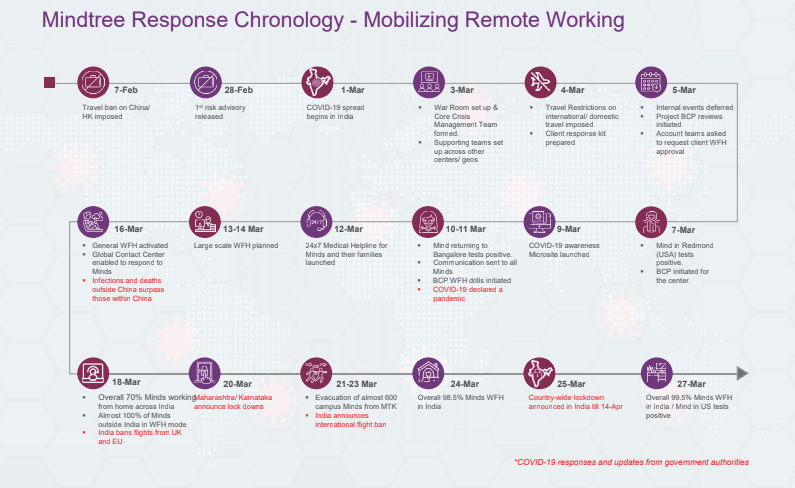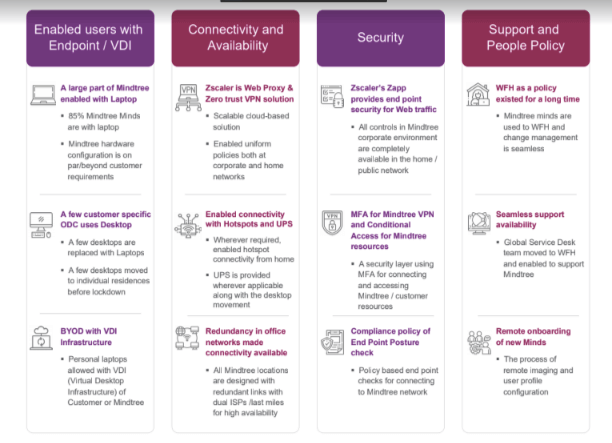A glimpse of how Mindtree successfully handled the COVID-19 situation and switched over to remote working by employing a variety of different measures.
Abstract
The unprecedented spread of COVID-19 has taken the world by storm. Everyone has felt its effects, regardless of their position on the economic, political, or sociological plane. Amidst the chaos, there are ways in which businesses have been affected, including coming to a grinding halt, in some cases. If the situation with COVID-19 has taught us anything, it is that truly agile companies need to plan for an unfathomable range of exigencies to ensure business continuity.
Although commentary on the future of work has been flagrant, very few large organizations were able to mobilize their remote working models at breakneck speed. More importantly, fewer were able to do so in a manner that caused minimal disruption to their business. Businesses that were successful in ensuring little to no disruption were armed with a host of technology tools that allowed for swathes of employees to work from home within hours.
In this paper, we will take a look at how Mindtree handled the COVID-19 situation to ensure the safety of its employees with no disruption to client deliverables and the technology that enabled it to move so quickly.
Introduction
It is now widely acknowledged that the 21st century is an extremely VUCA (Volatile, Uncertain, Complex, and Ambiguous) world, where very high levels of preparedness have been developed to tackle unforeseen circumstances. Late last year and earlier this year, when the Coronavirus scare was limited to China, there was little expectation that it would grow to such pandemic proportions. Business went on as usual and in small pockets, there was news emanating about this Novel virus that was taking the lives of people. However, as it hit foreign shores, in the second half of February, businesses started to worry and companies were left scrambling to devise ways to keep their doors open.
Problem Statement
At that point, things started to fall out of place. First, although all companies have business continuity plans in place to ensure smooth running of operations, there are very few who keep those plans updated and some who do, cover just a very narrow set of scenarios. Second, if a continuity plan is activated, many are left running around to figure out ways to ensure that employee base can work from remote locations. Lastly, there are a huge set of challenges regarding workplace security, remote working infrastructure, collaboration and productivity measures.
Overview of the Solution
To tackle the problems that arose from the situation, Mindtree devised a plan which covered four different, but essential areas - health and safety, business continuity, client support, and communications. The primary idea was to ensure that, even though the systems would be changing shortly, everything still functioned without a glitch. This meant that a lot of movement had to be done, and it had to be done quickly.
By March 3, a ‘War Room’ had been set up and a core Crisis Management Team formed. Across geographies, supporting teams were also set up, and shortly afterwards, all internal events / large gatherings were deferred, Project Business Continuation Plan reviews were initiated, and all account teams were instructed to ask clients for work from home approval. Shortly, a COVID-19 awareness microsite was launched to ensure that all employees were aware of the gravity of the situation with updates available in a single place.
Within a week, general guidelines were established for all employees to work from home. By March 16, the entirety of our workforce in non-India locations was in remote working mode, while 70% employees in India were also working from home - well before the government-enforced lockdown, which was only a week later. Also, to encourage the idea of social distancing, our cafeterias had just one person per table.
A Deep Dive
We started with the basics: a central team in India and parallel teams in Mindtree locations across the globe. At the helm of this team was the Chief Risk Officer, who with other war room associates, looked at multiple perspectives to arrive at decisions that would become immensely important over the following weeks. All the cities were monitored closely, and all the possibilities were drafted for every level, mapped on a flowchart.
In parallel, we started preparing our internal systems and POCs to be fully enabled for this transition. Even though some clients hesitated initially, all customers eventually agreed to have their project teams work remotely.
A number of key aspects helped Mindtree move at a pace faster than most of its peers to enable business continuity:
- Hardware : The laptop policy at Mindtree is extremely well thought out to ensure that all employees are equipped with systems not older than four years, which ensures that everyone has hardware with the most updated configuration.
- Culture of WFH : Mindtree allows six days of Work from Home (WFH) for each of its employees. So, even in the past, they have been 100% productive and connected whenever they have worked from home, and this practice has been inculcated over the years. Once we initiated the plan, the efficiency of WFH routines had to be taken care of. It was absolutely crucial to understand what was happening, and to bring a sense of structure to proceedings. Our Head of Quality and Head of Delivery Excellence made sure to check on the efficiency of the newly established routines. We formed a BCP anchor team for all verticals and used a hub and spoke model to ensure proper channels of communication.
- Collaboration Tools : Mindtree employees proactively use Microsoft Teams to collaborate with each other and their clients to ensure that there are no roadblocks in terms of ensuring quality delivery. This has been standard practice for over a year to ensure that internal and external collaboration, which is key to the business, does not take a hit under any circumstances. The usage of MS teams has increased by 2.5x, which ensured there were no deficiencies in the final deliverables.
- Global Contact Centre : A Global Contact Center was activated to respond to the anxieties of Mindtree employees. We also signed up with an International SOS and Medical Buddy for 24/7 health support to all employees. We made sure of the availability of this support team comprising a team of doctors working remotely, so that employees could call in case of any emergency. We also created a microsite to answer frequently asked questions, apart from establishing a COVID-19 news feed.
- Agile - Daily standup : Mindtree practices agile methodologies across all development projects. A key part of that is daily stand up meetings that are held to make sure that everybody reports their tasks to the Delivery Manager and are aware of all their upcoming tasks in a very efficient manner. Having this practice ingrained across different delivery teams ensured that there was little change in the day-to-day activities that were carried out in this transition.
- Kalinga : At Mindtree Kalinga, our global learning and delivery center in Odisha, we closed down the residential center in two days. Air tickets were arranged for about 400 fresh out of college hires, and their families were reassured of their safety. The in-house travel team was a key enabler to ensure that within a short span, all travel arrangements were in place to get the employees to safety.
- Learning Platforms : For team members who were not allocated to projects, the learning team engaged with them through our in-house learning platform, Yorbit, with the aim to upskill them. This ensured that during their downtime, the employees remain engaged and used their time productively to learn new technologies.
- Video and chat – collaboration support : While structure, discipline, and community were essential during these times, productivity also came to the forefront - not just of an individual but of the entire team. We also ensured that all employees were offering high-touch, collaborative support to clients through video and chat. Moreover, we were also able to sufficiently mobilize remote working for IP-related development as well.
At this point, we were actively strategizing how to invigorate the talent and prepare them to be creative. We had a task force to energize teamwork with a scrum master so that the team could be motivated. They were encouraged to follow daily routines as usual - take a shower, get ready, be at their computer, and to be as active as possible online. Our task forces also found ways to lighten the situation, by playing games, taking quizzes, and more! Using Yammer to connect with other teammates across Microsoft Teams also made for an interesting process.
Mindtree also captured all the data on its own delivery platform - which was also used for various other needs during the crisis period. The Head of Travel was tracking internal travel going on at all points, while international travel was halted. At first, only essential travel was permitted within the country, but then, even that was stopped. Those who were stuck were taken care of on a priority basis.
What enabled 100% WFH
Summary
It was a combination of a slew of measures that we undertook early on which helped us ensure the safety of our employees with zero impact to client deliverables. From setting up the war room to conducting mock drills to taking measures to ensure productivity and creativity during WFH routines to upskilling Mindtree employees on Yorbit, every possible measure was taken to ensure that the continuity of business wasn’t interrupted. And the results are evident. The usage of MS Teams has risen by 2.5x, and there was no loss in billing in the month of March.
Download the whitepaper to learn more



